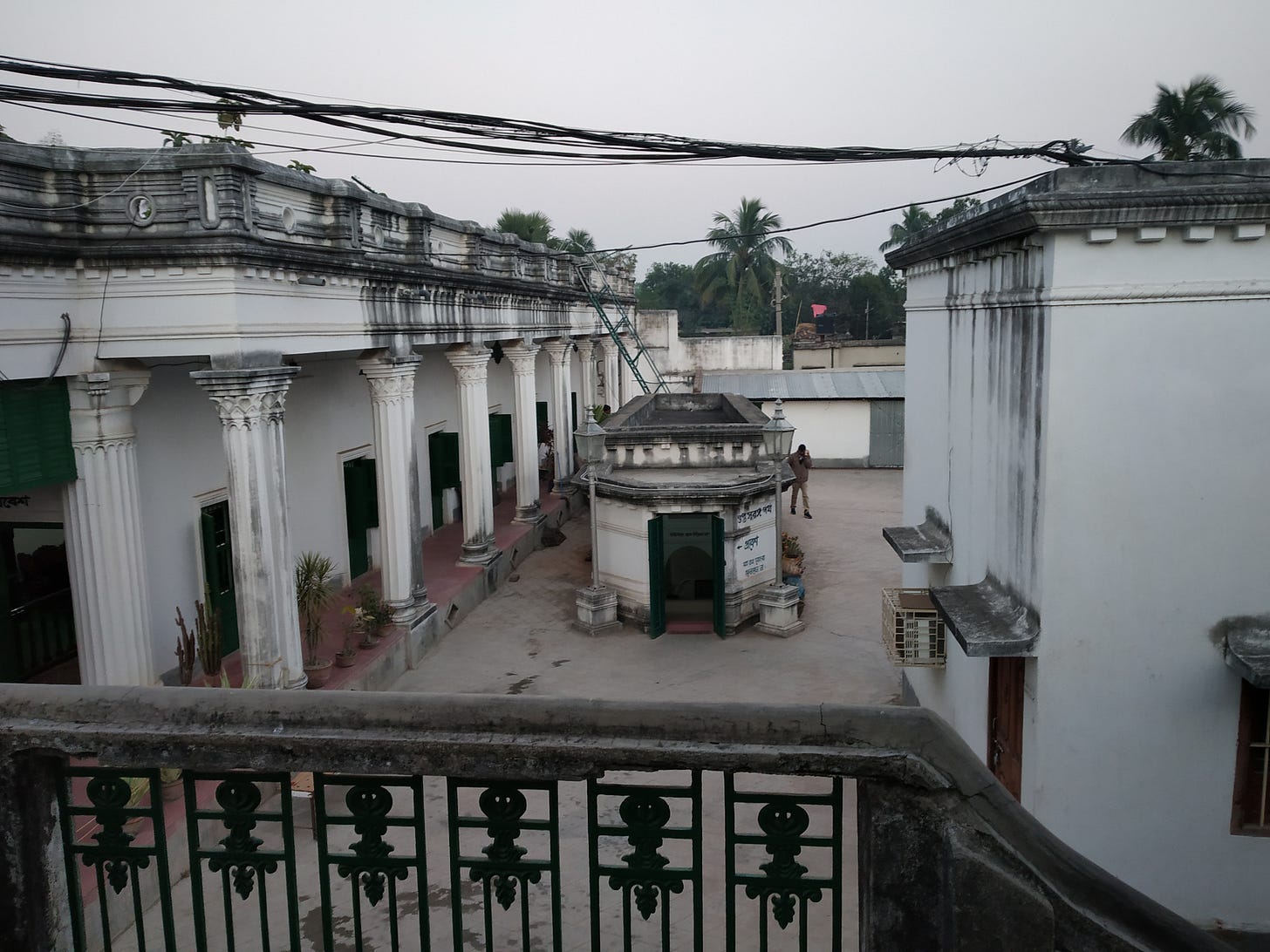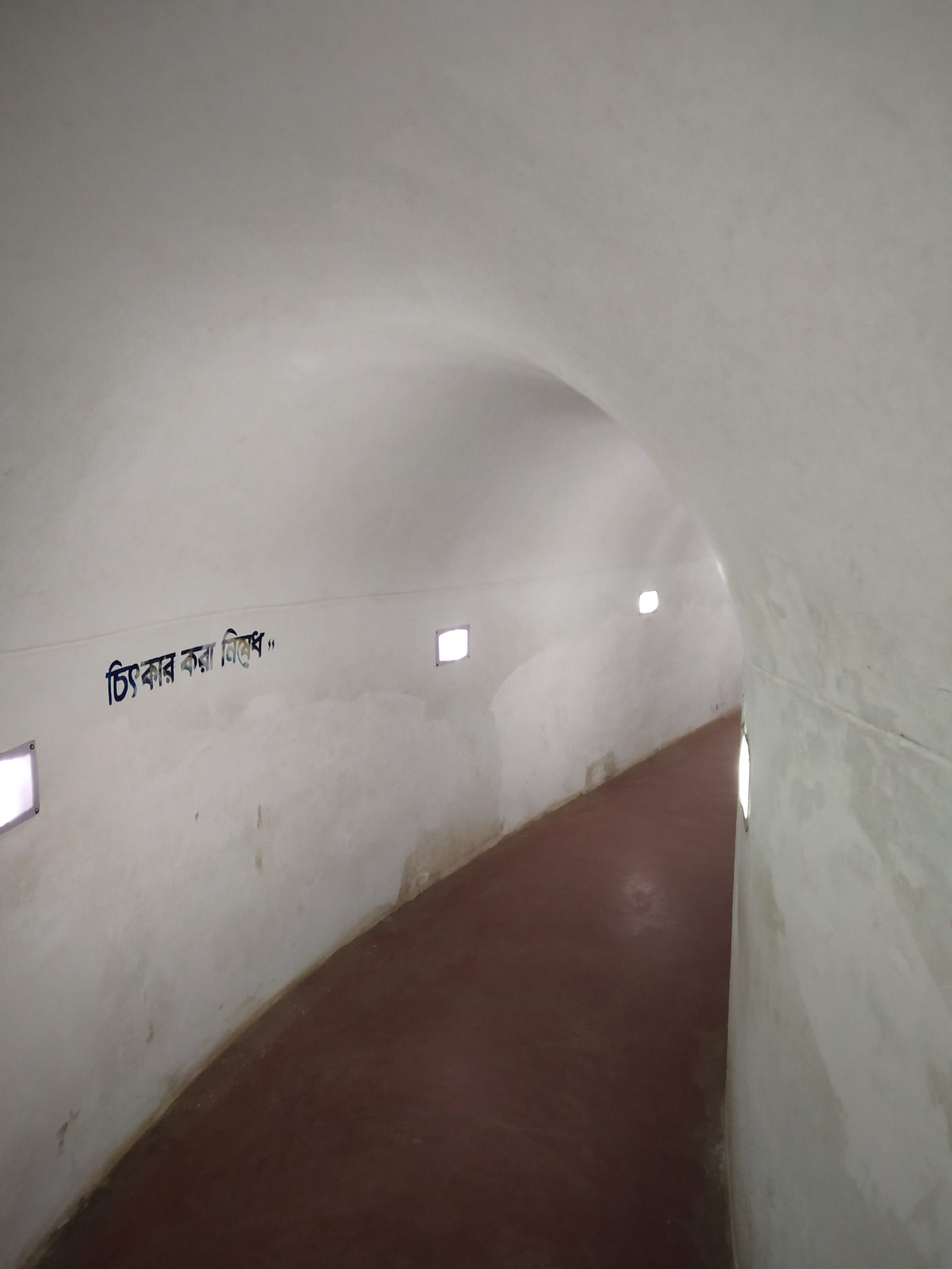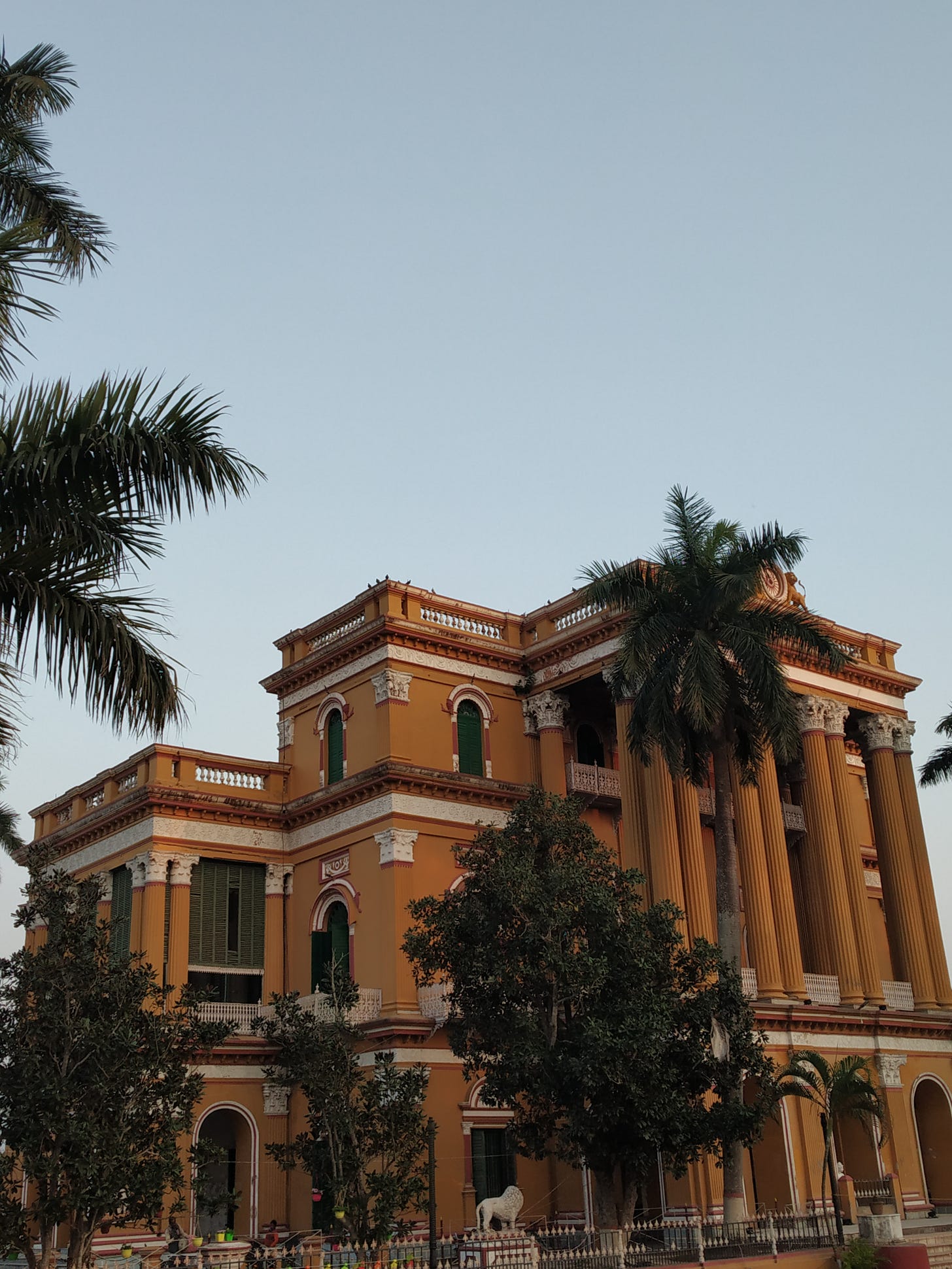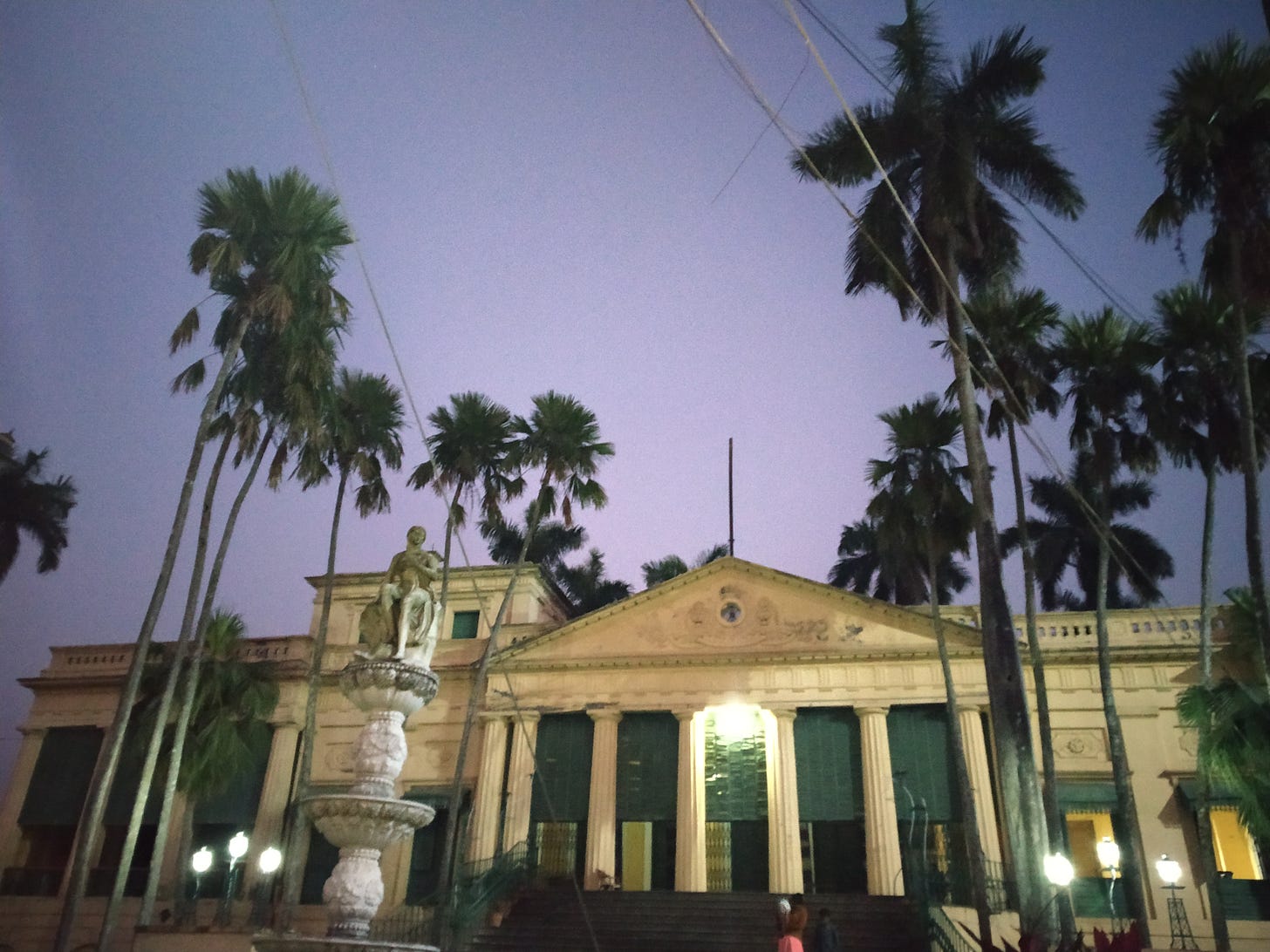For Part 1, please click here
I stepped out of the Murshidabad station to the sounds of cymbals and drums thrashing as a Kali Puja was underway in the adjacent shrine. As I stood in rapt attention watching it rise to a crescendo, an auto driver approached me. Seeing that I was a traveler, he offered to take me around. He said for only five hundred rupees, he will take me to all the sites on this side of the river. I imagined this would take all day and I thought it was a fair deal. Besides, Gopal had a warm smile. I soon realised I had been had because all the sites on this side of the river were only short walks away from each other; Murshidabad was tiny.
The city was founded by Murshid Quli Khan when he moved the capital here from Dhaka in order to assert his independence, away from the baleful presence of Aurangzeb’s grandson Azim-us-Shan. Aurangzeb had appointed Murshid Quli Khan as the governor of Bengal in charge of revenue collection while Azim-us-Shan was the Subehdar, in control of the troops. He saw Murshid Quli Khan as a problem because he wanted full control of the revenue of Bengal to launch a bid for the Mughal throne once Aurangzeb died. Auragnzeb on the other hand was impressed by Murshid Quli Khan’s administrative skills and the much-needed revenue he sent to him as he continued to fight his costly wars in the Deccan. In time, as Aurangzeb came to trust Murshid Quli Khan, his power grew and after an assassination attempt by Azim-us-Shan, Murshid Quli Khan had had enough. He decided to shift the administrative capital to a small town called Makhsudabad where he would feel safer. Aurangzeb was so impressed with his work that he allowed him to rename Makhsudabad after himself to Murshidabad.
As the governor of Bengal, Murshid Quli Khan had cultivated ties with several Hindu and Jain money-lending families. When he moved to Murshidabad, some of them accompanied him. The most important among them was Manikchand, a Shwetambar Jain whose family had roots in the Marwar region of Rajasthan and who had a particularly close relationship with Murshid Quli Khan. According to some sources, it was Manikchand who was behind the suggestion to make the move to Murshidabad. Once there, Manikchand’s family became the bankers of the Nawabs. He became such a vital cog in the finances of Bengal – the richest state in the Mughal Empire – that Manikchand helped Farrukhsiyar become the Mughal Emperor after Aurangzeb’s death in 1707. For this, Manikchand and his family were bestowed with the title of Jagat Seth – bankers of the world - by the Mughal Emperor. The title represented a family institution of unparalleled wealth and power. When Manikchand died in 1714, his nephew Fatehchand succeeded him and it was during his tenure in the 1720s that the Jagat Seths reached the height of their powers. They oversaw two-thirds of the revenue, facilitated the transfer of taxes to Delhi and farmed the mints of Murshidabad and Dhaka over which they had established a monopoly thanks to their relationship with Murshid Quli Khan. Robert Orme, who was the official historian of the East India Company and had visited Bengal in the early 1750s referred to the Jagat Seth as ‘the greatest shroff and banker in the known world’. During this time, the Seths became the principal money lenders to the various European trading houses in Bengal including the East India Company. In his Anarchy, William Dalrymple writes about how the relationship developed as a result of the EIC earning a reputation for paying their debts regularly, unlike the Bengal Nawabs.
There is no account of the wealth of the Jagat Seths without indulging in exaggerations; but we do get an indication of its scale when the Maratha army under Mir Habib invaded Murshidabad in 1742 and looted Rs 2 crore in cash from the house of the Jagat Seths as reported by Gholam Hossein, the author of the Seir.
With wealth that became a part of lore, the Jagath Seths also had uncanny political instincts. After the death of their political partner Murshid Quli Khan, they used their power more overtly to make changes. Their tentacles were so deeply entrenched in Bengal’s economy that they were always able to back the winning horse and they usually picked people of ability who could work with their interests. It was the Jagat Seths who manoeuvred Alivardi Khan’s rise to the throne, ushering in what has come to be known as a period of expansion and prosperity for Murshidabad. After the death of Alivardi Khan however, the then Jagat Seth Mehtab Rai found it difficult to deal with his hot-headed grandson Siraj. In their latest political manoeuvre, they decided to back the British against him. They bet correctly again, but this time they had backed a power they did not understand.
The battle at Plassey turned out to be a pyrrhic victory for the Seths and their interests. Their wealth and power stemmed from the Nawabs of Bengal; they knew that system well and had manipulated it with networks stretching across the Empire. By supporting the British, they upended all that and unleashed forces they had no way of controlling. While they remained the bankers of the British after Plassey, a few years after the battle of Buxar in 1764, the Jagat Seths were replaced. A few years after that, Bengal faced its worst famine in 1770 in which a third of its population perished. A new kind of extractive power was on the ascendant which would spread, locust-like, from Murshidabad to the rest of the subcontinent. It signalled the shift of power, prestige and wealth from Murshidabad to Calcutta and with it, the fading away of the Seths. In the early nineteen hundreds, the last of the Seths died while surviving on a meagre British pension.
Murshidabad’s fortunes rose and fell with the fate of the house of the Jagat Seths. And so even though I had visited the immense Hazarduari Palace a couple of kilometers away, once Gopal stopped his auto outside the Jagat Seth house, I felt like I was visiting ground zero of Murshidabad, its nerve center. While there were some displays in glass cases harking back to that time, the first impression I got was that of Hobbit-hole as so much of it was underground tunnels and vaults with entrances and exits in different parts of the house. You got the sense that this was a house built by people who had much to hide, the home of so many plots and machinations. It was after all in this house that Clive, Mir Jafar and the Jagat Seth decided to seal the fate of Siraj-ud-Daula at Plassey. I was struck by the lack of ostentation and grandeur; as fascinating as the structure was as an example of an eighteenth-century merchant house, I would not have guessed that this was where the wealthiest family in the world had lived.
Close to the house was an old gateway in ruins. I asked Gopal what it was and he said it was the Namak Haram Deorhi, the traitors gateway. He said that it was the doorway to Mir Jafar’s palace and although the palace no longer exists, his descendants still live there so tourists are not allowed. Mir Jafar’s name has gone down in history as a byword for treachery. He was the face of it, becoming the British controlled Nawab after Siraj and I visited his grave at the Jafargunj cemetery where he lies with his descendants. In contrast, Siraj has been redeemed as a hero who opposed the British even though contemporary local sources spoke about how ill-suited he was to assume the responsibility of Bengal. The Jagat Seths on the other hand, who attempted to address the bad-emperor problem that is an inevitable consequence of primogeniture, have been spared Mir Jafar’s legacy because they worked behind the scenes.
Their wealth brought other Hindu and Jain Marwari families to Murshidabad over time who became a part of the extended network of trade and moneylending built by the Jagat Seths. They were followed by the Dugars, Nahars, Dudhorias, Kotharis and Nawlakhas. By the 19th century, some of them would overshadow the Jagat Seths in wealth forming the Sheherwali (urban) Jain community of Murshidabad. Over the years they built so many Jain temples across the city that Murshidabad has become a place of pilgrimage for the Jain community today. But while these families maintained homes in Murshidabad, the momentum for wealth creation in the East had shifted to Calcutta and to Zamindaris where their interests lay.
The families were connected to each other through business and marriages and their houses still stand in various stages of upkeep. The best maintained among all the Jain family homes of the city is the Kathgola palace built by the Dugars with a Jain Temple tucked away inside the sprawling gardens. The name of the palace comes from a wood rose that grew in these gardens once. More than the House of the Jagat Seths, Kathgola Palace looks like it belonged to wealthy people. The tall structure stands with the support of yellow arches and columns with palm trees to match standing guard next to them. In front of the Palace is a small lake with white steps leading into it from different directions and a small distributary of the Bhagirathi flows placidly behind the garden. The Dugar family has converted the palace into a museum allowing you to climb the floors looking at paintings and furniture right up to the terrace.
In contrast, the Nashipur Rajbari built by the Singhas is in ruins. Looked at from outside, it is still very beautiful with a triangular Greco-Roman façade and pillars with palm trees swaying around it. But its insides have been devoured by weeds and moss leaving me worried about which Singha I might encounter emerging from a tall European window when I visited it in the late evening with no fellow visitor in sight for reassurance.
Today, these uninhabited homes of Marwari bankers that have become tourist sights are like the skeletal remains of a city that once thrived enough to attract them. After the battle of Plassey, the decline of Murshidabad was slow but inexorable, with its relevance in the political economy consumed by a growing Calcutta. While cities rise and fall, Calcutta and Murshidabad are an example of a city’s rise being fed by the decline of the other as Murshidabad paid the price of having its economy controlled by the interests of one family. Calcutta continued to hold its sway over Murshidabad even during the partition of Bengal in 1947 when it competed with Dhaka over which districts would come under their sway.
As a border district that had a Muslim majority in 1947, Murshidabad was not supposed to be a part of India. But if I didn’t need a visa to come here, Calcutta, the city I had left behind, was responsible. Murshidabad lay on the eastern bank of the Bhagirathi River, a distributary of the Ganga-Brahmaputra river system. With the partition of India imminent, the Bengal Congress knew that the health of the economy of Bengal depended on Calcutta thriving as an entrepot. With partition and the loss of Chittagong and Dhaka, this dependency would only increase. For trade in Calcutta to thrive, the Bengal Congress thought it was necessary for them to be able to control the flow of water into the Hooghly River and keep it flush with water throughout the year. They could do this only if they had control over the northern distributaries in Murshidabad and Malda that fed into the Hooghly. But both Murshidabad and Malda had Muslim majorities. So the Bengal Congress decided on a trade-off. They proposed keeping Murshidabad and Malda in exchange for the much larger Hindu majority Khulna district.
As Joya Chatterjee puts it in her book, “The spoils of Partition”
“…indeed if push came to shove, the Congress was ready to trade Khulna for Murshidabad. Yet if Khulna went to Pakistan, Hindu-majority areas in Faridpur and Bakarganj which could have been claimed for West Bengal on the ground of contiguity to Khulna would also end up in Pakistan. This, however, was a price the Bengal Congress was ready to pay in order to keep Murshidabad in West Bengal and to ensure the integrity of the Ganga river system.”
Calcutta’s needs trumped the logic of demography that was being used to divide the land. Seen on a map, the interconnected Hooghly and Bhagirathi rivers were the geographical tethers that Calcutta used to bind Murshidabad to itself politically.
Plassey - where the change in relations between the two cities began - is 40km from Murshidabad. I took one of the several trains that ply everyday on the Sealdah-Lalgola line through which the Murshidabad district continues to service Calcutta’s labour needs. The peak hour rush on these trains can make boarding them a challenge. On the way to Plassey, I discovered another railway snack that I had not seen before. The vendors were calling it kacha-amloki and it consisted of thinly sliced pieces of a fruit coated in a pungent green paste sold in small plastic sachets. I liked the sharp flavor and bought them often only later to find that I was chomping on amla.
I had a couple of these sachets with me as I walked from the Plassey station to the battle memorial. The road that leads up to the small enclosure is marked by government housing and mango trees. An obelisk made of cement mounted on a plinth marks the spot and in front of it is a metal bust of Siraj painted gold. The bust and obelisk are surrounded by weeds enclosed by a brick wall and a rusty gate. The Palash trees that gave the site its name no longer exist. The space is far too small to have been anything more than a sliver of the battlefield. There were no boards or placards that attempted to inform the visitor about the battle and its historical context. So little commemorates a moment that changed so much.
I leave you with the voice of a blind singer from Murshidabad I heard on the station while waiting for my train to Plassey; I loved how he hit the high notes. Now when I think of Murshidabad or Plassey, I first think of his song.












So much I did not know about. So much I do not know about, but I am not worried about all that. You know why? Because of you. Thank you Ayush. Also, the video...just. Thank you.
Superb piece, Ayush. I am ashamed to admit that I've never been to Murshidabad. Your wonderful post has made me want to rectify this. Perhaps I should plan a visit the next time I'm going home to Kolkata.